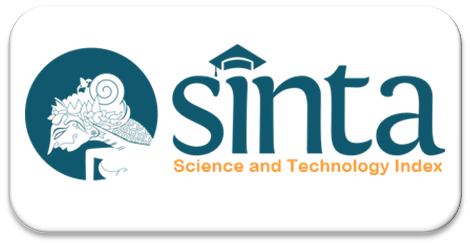Analisis Faktor-Faktor Yang Mempengaruhi Kepuasan Perawat Pelaksana Terhadap Rotasi Ruang Di Rsud Dr. R. Goeteng Taroenadibrata Purbalingga
Abstract
Background: The rotation or rolling has a sense of play or rotate the placement of the structural and functional than a certain position to other positions specified in a policy which is compulsary. While the rotation is interpreted as a punishment and procedures remain in the hospital is still technically there is no explanation about the reason of the rotation.
Research objectives: to analyze the factors that affect satisfaction of nurses implementing the rotation of space in hospitals dr. R. Goeteng Taroenadibrata Purbalingga.
Research Methods: This type of research used in this study is correlational analitic. Sampling in this study uses total sampling technique using a questionnaire as data collection tools were distributed to 74 respondents. Analysis of the data used is a multivariate analysis of Logistic Regression. Research
Results: The results of this study is the third of the factors that memepengaruhi rotation space is there a significant effect among the three factors that affect the implementation of nurse satisfaction in hospitals roatsi space dr. R. Goeteng Taroenadibrata Purbalingga (Opportunity to advance p value = 0.018, Colleague p value = 0.010, p value working conditions = 0.004). The most dominant factor of the rotation of space in hospitals dr. R. Goeteng Taroenadibrata Purbalingga is a significant opportunity for advancement, where the p value 0.025 <α = 0.05. Conclusion: The most dominant factor of the rotation of space in hospitals dr. R. Goeteng Taroenadibrata Purbalingga is an opportunity to advance.
Key words: Analysis of the factors that affect nurse satisfaction executor, nurse executive, the rotation of the spaceReferences
Anoraga, Pandji & Ninik Widiyanti. (1993). Psikologi Dalam Perusahaan. Jakarta : RinekaCipta.
Arikunto, S. (2010). Prosedur Penelitian Suatu Pendekatan Praktik. Jakarta: Rineka Cipta.
As’ad, Moh. (2001). Psikologi Industri. Yogyakarta : Liberty.
Gillies DA. (1996). Nursing Management: A Systems Approach. 2nd ed. Philadelphia: W. B.Saunders Company,
Gomes, Faustino Cardoso.(2001). Manajemen Sumber Daya manusia. Yogyakarta : Andi Offset.
Hasibuan. (2008). Manajemen Sumber Daya Manusia. Jakarta : Bumi Aksara.
Hidayat, A.A. (2009). Metode Penelitian Keperawatan dan Teknik Analisis Data. Jakarta: Salemba Medika.
Macfoed I. (2007). Teknik Membuat Alat Ukur Penelitian Bidang Kesehatan, Wawancara, dll.Yogyakarta: Fitramaya.
Mangkunegara, A.A. Anwar Prabu. (2000). Manajemen Sumberdaya Manusia Perusahaan.Bandung : Remaja Rosdakarya.
Mayasari A. (2009). Analisis Pengaruh Persepsi Faktor Manajemen Keperawatan Terhadap Tingkat Kepuasan Perawat Di Ruang Rawat Inap RSUD Kota SemarangTahun 2009. Program Pascasarjana Universitas Diponegoro Semarang. (tidak dipublikasikan)
Notoatmodjo, S. (2005). Metodologi Penelitian Kesehatan. Jakarta: Rineka Cipta.
Nursalam. (2007). Manajemen Keperawatan, Aplikasi dalam Praktek Keperawatan Profesional.Edisi 2. Jakarta : Salemba Medika.
Prosedur tetap Rotasi, (2009).RSUD dr. R. Goeteng Taroenadibrata Purbalingga Siagian, Sondang P. (2001). Manajemen Sumberdaya Manusia. Jakarta : Bumi Aksara. Sugiyono. (2007). Statistika Untuk Penelitian. Bandung : Alphabetha.
Saydam G. (1996). Manajemen Sumberdaya Manusia Suatu Pendekatan Mikro. Jakarta:Djambatan
Syamsu Aprizal, Tjahjono Kuntjoro, Ari Probandari. (2008). Kepuasan Kerja Perawat Di Rumah Sakit Jiwa Prof. HB. Sa’anin Padang. Working Paper Series No. 17 April 2008.
Tjokrodipo B. (1999). Tingkat Kepuasan Kerja Terhadap Sistem Imbalan dan Faktor Pekerjaan di Rumah Sakit Budi Kemuliaan Jakarta. Tesis. Program Studi Kajian Administrasi Rumah Sakit. Fakultas Kesehatan Masyarakat Universitas Indonesia, Indonesia. (Tidak dipublikasikan).
Anung Pramudyo. (2010). Analisis faktor-faktor yang mempengaruhi kinerja dosen negeri dipekerjakan pada kopertis wilayah V yogyakarta. http://jurnal.umy.ac.id/index.php/jbti/article/view/1456/198. (diakses tanggal 2 Juli 2012).
Budiman, dkk. (2009). Analisis faktor dominan motivasi kerja perawat di instalasi rawat inap RSU Banyuasih Purwakarta. Jurnal Stikes Jendral ahmad Yani Cimahi. http://www.stikesayani.ac.id. (diakses tanggal 2 Juli 2012).
Subakti Syaiin. (2007). Pengaruh Kepuasan Kerja terhadap Kinerja Pegawai Klinik Spesialis Bestari Medan. http://ropository.usu.ac.id/xmlui/handle/123456789/7046. (diakses tanggal 3 Juli 2012)
Lauga, dkk. (2009). Hubungan faktor-faktor motivasi dengan kinerja perawat dalam melaksanakan asuhan keperawatan di ruang rawat inap RSUD Kefamenano Kabupaten TTU. http://isjd.pdii.go.id/index.php/search.html?act=tampil&id=538448idc=28. (diakses tanggal 3 Juli 2012).
Tian Hartini. (2007). Hubungan Persepsi Perawat terhadap Sistem Pengembangan Karier dengan Kepuasan Kerja di RSUP Persahabatan Jakarta. http://isjd.pdii.lipi.go.id/admin/jurnal/330719.pdf. (diakses tanggal 3 Juli 2012).
Downloads
Published
How to Cite
Issue
Section
License
Submitted paper will be firstly reviewed by the editors to determine whether the paper meet the edition theme and submission guidelines. Papers which meet the theme and the guidelines will be assigned to selected reviewers for peer-reviews. Viva Medika: Jurnal Kesehatan, Kebidanan dan Keperawatan is a double blind peer-reviewed journal which involves reviewers based on their experties relevant to the topic of the paper. Final decision of paper acceptance is solely decided by the editors according to reviewers' comment.
Plagiarism and self-plagiarism are prohibited. Viva Medika: Jurnal Kesehatan, Kebidanan dan Keperawatan uses PlagiarismCheckerX and iThenticate to scan papers for detecting plagiarism. Thus, Appropriate citation and quotation should be used

.png)








